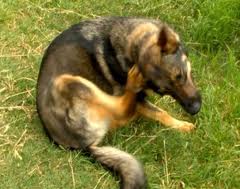Lice In Dogs
If it is caught early enough can be very easy to control but only if you catch it early
Lice in dogs are still a very large problem, but it is very different in nature than fleas, and is much easier to get rid of in your pet than fleas.
They will pose no real serious health dangers to your pet, unless they carry an infection, which could become a threat to your pet, but it is very rare for lice to carry infections, unlike ticks or fleas.
Fleas have very strong back legs which enable them to jump from host to host or from the environment onto their host or your dog.
While lice are very host specific and will not leave your dog once they have infested your pet.
Lice will stay on your pet unless treated and removed for their entire life cycle, which is normally between 18 and 21 days.
However, if they are not caught and treated, and lay eggs, this cycle could be much longer for your pet.
HOW THEY ARE TRANSMITTED
Transmissions of lice in dogs can only be by direct contact with another animal, again because they are not persistent to attack another host.
However, it must be noted that grooming instruments that you use on your dog or puppy can transmit lice to another dog.
The species of lice that will infest your dog or your puppy will not affect you or your children.
They do not like human hair or skin, and conversely the species of lice that can infest humans do not like dog hair or skin.
THE TYPES OF LICE IN DOGS
 Lice in dogs will severely damage their coat
Lice in dogs will severely damage their coatThere are three very distinctive species of lice that will attack your dog and they are divided into two groupings.
The first grouping is what is referred to as biting louse, or lice, and they are called Trichodectes canis, or Heterodoxus spiniger and are categorized in the Mallophaga species of lice.
The sucking species of lice that will attack you dog are referred to as Linognathus setsus, and they are in the Anoplura grouping of lice.
This condition can be very easy to spot on your pet, as they can easily be seen with the eye. They will appear as if they are flat and will have no wings like other insects.
What is quite startling about lice is that there about 3,000 species of lice that chew or bite their victims, and about 450 that suck their hosts, or victims.
In the biting lice in dogs, these insects will have mouths that are specially designed for biting or chewing and they feed specifically on your dog or puppy’s hair or the scales of their skin.
These particular forms of lice are about half again larger than the sucking form of lice, making them that much easier to spot.
The sucking form of lice will have mouth-parts that are designed specifically to penetrate your dog’s skin.
Then they suck the blood and these mouth-parts will actually find their way into your dog’s blood vessels and then suck the blood from the vessel.
These forms of lice are much more irritating to the point of actually being painful to your dog or puppy as they can cause severe irritations because of this penetration.
What also makes them more of a threat is that their sucking processes can cause reddish like papules that expose the skin.
This can, in extreme cases, lead to both dermatitis, which is inflammation of the skin, and or secondary infection.
THE SYMPTOMS AND TREATMENTS
The most noticeable signs for you to watch for in your dog will be a very scruffy or dry hair coat.
Your dog may even start to lose some of their hair, primarily because of the itching, especially if severe.
When examining for lice in dogs if you suspect infection, they will basically look like dull white flakes, almost resembling dandruff if they are the biting species.
If you’re pet is infested with the sucking form, they will than appear as a dark, almost dirty color.
The eggs that they may have laid are referred to as nits, which will stick to your pet’s hair and will be about the size of the head of a pin.
The health threat to your dog or puppy will depend on how bad they are infected. A dog or a puppy can be infested with literally thousands of lice.
Severely infested dogs may become weak and as a result become more at risk for other infections or diseases.
The proper grooming of your pet will certainly alert you very quickly and can go a long ways to actually eliminating this infection.
The treatment for this infection is really quite simple.
Both types of the insects are killed very easily with several popular flea and tick products, as well as dog shampoos.
Creolin, DDT powder, and household vinegar are also effective home remedies.
SUMMARY
However, even though several sources will list Malathion as a remedy, it has had several reported incidents of severely weakening you pet’s immune system.
Because of this it should not be used as a remedy.
Lice in dogs are easily spotted, and if caught very early, you can save your pet a lot of unnecessary misery.
Pet Medications for Lice In Dogs
Dog Vitamin Store
Dog Skin Health








